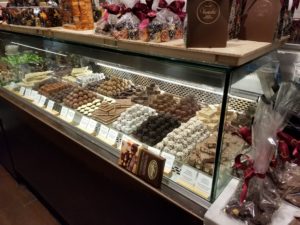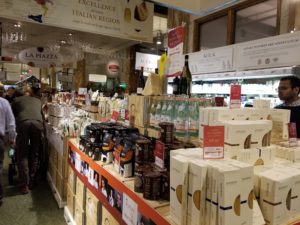Kayla Cabral, 21, occasionally stops by Eataly to see what’s new. Since the organic fruits and vegetables here cost more than in other stores in the New York City, she only looks rather than buys. But she still adores visiting the one-story marketplace because of what it offers: an experience.
“I love how it tries to transport you to feeling as if you were in Italy,” said Cabral, a Parsons student. “Whole Foods is closer, so I end up going there, but I do really like this place.”
With its first-come-first-serve restaurants and their open seating, the center of the market is modeled after an Italian square. The intermingling smells of different foods like chocolate, cheese and fresh oysters entice the customers to check out the menus of the six different restaurants, three cafes and five counters that Eataly offers.

By constantly updating their offerings like the forthcoming Cannoli counter and Biata, the Italian alps pop-up restaurant that arrives during winter, it keeps bringing back students and tourists who may otherwise find the ingredients too expensive.
“I like cooking and the vibe is different here,” said Megan Heidenburg, 21, a freelancer with Lollywood, a production company, “but I don’t have much time, and the produce here is expensive.”
Eataly, the Italian marketplace concept, first opened in Torino, Italy. Since then, 12 other locations have opened in Italy and four others in the United States. There are two places in Manhattan: Eataly Flatiron, which opened in August 2010, and, Eataly Downtown, which opened in August 2016. As of 2015, Fast Company notes that the 50,000 square-foot food emporium in Flatiron has made around $85 million in annual revenue.
“My mom loved the concept of the market place vibe,” said Atharva Bhandarkar, an NYU student. “It’s a refreshing idea but I’ll probably keep going to Trader Joe’s.”

For those who want to pay the higher price, the produce section is delivered and restocked twice daily. According to the New York Times, some of the produce is shipped in from Italy, like the Italian frisée and the radicchio di Castelfranco (a red-streaked, bitter yellow leafy vegetable), while the rest is brought in from farms around the United States.
For people who have been to Italy and frequented the markets, however, the experience falls short. Cabral who has been to Italy and visited many markets has to concede that “the aesthetic of the market is very different from the market experience in Italy.”
At the end of the day, Eataly is a business — there’s no bargaining, for example.
“It’s too commercial compared to the ones I saw in Italy,” said Cabral. “I’ll still keep coming back because it’s the closest thing in Manhattan, but it lacks that extra-personal feel.”
If you consider the fact that the goods are shipping in from Italy, the prices may not seem absurd. For the younger crowd in this area though, it might be just slightly too high. But Eataly will continue to offer a unique market experience with a changing atmosphere that will keep many coming back until they might one-day be ready to shop there.
